Mothers at the Museum
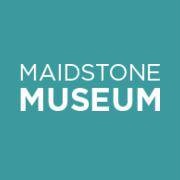
Mothering in the collection
By Pernille Richards BA Hons, MA, AMA
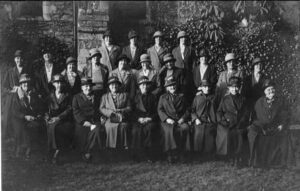
Inspired by Mother’s Day, the Collections Officer decided to search the catalogue to see how mothers are represented in the museum collection.
Motherhood intersects with the public realm in the dynastic fortunes of great families, the role of the family in society and its economy, and in society’s values and expected norms for women. It is also an intensely private experience and much influenced by social and economic circumstances and the period of time in which a person lived. This experience and the day-to-day work of women has not historically been collected by museums to any great extent. The limited number of objects which were found in the Maidstone collection are spread over many centuries and cultures. This blog will focus on a few key themes relating to motherhood in Britain, but recognises it is unable to cover all types of mothering.
Pregnancy
Before reliable contraception, most married women spent much of their lives bearing and raising children. During the 17th century the phrase ‘big -bellied’ or ‘great bellied’ woman was a common term, and the average woman would give birth six or seven times. Pregnant women from wealthy backgrounds are sometimes depicted in art, but the most common image of a pregnant woman in Western art is the ‘Annunciation’. The depiction of the visit of the angel Gabriel to the Virgin Mary where she is told she will become the mother of God. Mary was in the Western tradition an expression of the ideal of motherhood. There are few early accounts or objects relating to the experience of pregnancy by ordinary women, but they become more plentiful from the 19th century onwards.
The 19th century maternity corset on display in the Costume Gallery is the best-known object in the collection relating to pregnancy. It is made of sateen and whalebone and has tape shoulder straps and a white cotton gusset at the breast and hips which allow for expansion to accommodate the growing baby. The corset has the busks sewn into the centre back and laces down the front. It is difficult to tell what it would have felt like to wear it. Would it have felt very restricting or supporting to some measure?
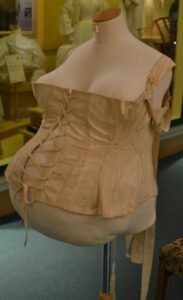
Maternity Corset
An Edwardian skirt of blue linen (NO_ID311712) has darts inserted at the waist to expand the garment indicating it was altered to accommodate a pregnancy.
No other items are associated with pregnancy until we get to the wardrobe of Doreen Lady Brabourne (1896 -1979) where a couple of blouses and a tunic are tentatively identified as possibly being maternity wear. Here the emphasis is very much on comfort and ability to move. The tunic is loose fitting with a Peter Pan collar in vibrant raspberry pink, blue black and yellow. All the items were in the new material Rayon, showing that contemporary fashions have always been adapted for pregnancy.
Birth
Until the 20th century most women gave birth at home attended by other women. Some birth helpers were experienced practitioners who had learnt their craft in an apprentice model, others were less qualified. From the 17th century onwards, there were great advances in medical knowledge, including anatomy and the process of birth. Two early influential books were, Jacob Rueff’s textbook, ‘The Expert Midwife’, published in English in 1637, and ‘The Midwives Book’ by Jane Sharp, published in 1671. An important text on anatomy by the surgeon Thomas Vicary called ‘The English-Mans Treasure with the true Anatomie of Mans Body’ published in 1634 is in the collection. A more traditional approach is taken by another book in the collection, Nicholas Culpeper’s Directory for Midwives from 1774, a corrected version of an earlier work on conception, pregnancy and birth.
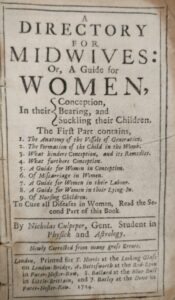
Nicholas Culpeper, A Directory for Midwives: Or, A Guide for Women. 1774
Death in childbirth has been reduced to a rare and tragic event, but it used to be more common. Humans evolved to walk upright, and this means that the female pelvis has to perform the twin functions of stable upright mobility yet still have enough space to allow for birth. There isn’t much room for error and although the process of birth usually goes well it can be hazardous for both mother and baby. In the past even a successful birth could end in death in the days or weeks afterwards, the most frequent causes being infections, usually referred to with the catch-all ‘childbed fever’.
A 19th century tea set made at Coalport, Staffordshire, commemorates the death of Princess Charlotte Augusta (1796-1817) following the birth of her son in 1817. The black and white soft-paste porcelain has a printed design with the wording “To the Memory of Princess Charlotte”. One image shows a cenotaph with a globe in front, angels and a grieving Britannia on one side. The other image shows angels surrounding a lamb on a pedestal.
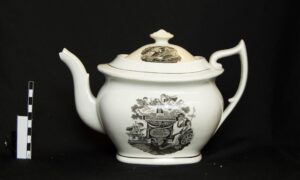
Teapot commemorating Princess Charlotte Augusta (1796-1817)
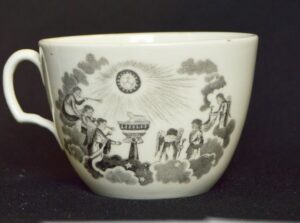
Detail of a teacup commemorating Princess Charlotte Augusta (1796-1817)
Princess Charlotte Augusta was the only child of George IV, Prince of Wales at the time, and Caroline of Brunswick. As the only legitimate heir, Charlotte had an important dynastic role, her child would be next in the line of succession. She married Prince Leopold of Saxe-Coburg (1790- 1865) on the 2nd of May 1816 and was soon pregnant. In November 1817 she went into labour at her home at Claremont, Esher. Princess Charlotte was attended by the accoucheur, or male midwife, Sir Richard Croft (1762-1818), and a team of other medical helpers. The male midwife was a phenomenon which arose during the 17th as part of advances in medical knowledge and the invention of forceps. Male midwives usually attended wealthier clients like Charlotte and were called on by midwives to assist in difficult deliveries. Charlotte was in labour for 50 hours before she gave birth to a stillborn son. She survived the birth but died suddenly about five hours afterwards. There was an immense outpouring of grief from the population at the death of the popular princess and the tea set was one of a whole range of mementoes to her.
Richard Croft never recovered from the trauma and criticism directed at him following Charlotte’s death and completed suicide in February 1818 whilst attending another difficult birth.
The 18th Century saw the growth of the first ‘Lying in Hospitals’, which were mostly charitable institutions and usually served poorer women. The Lying in Hospitals brought advances in obstetric care, but often had a high mortality rate as the need for hygiene was not yet appreciated. The role of microbes and the need for antisepsis were not fully established until the 1860s and childbed fever was a common cause of death.
Dr Thomas Charles, whose antiquarian collection formed the basis for the establishment of the Museum in Maidstone in 1858, attended births regularly. The journal of Edward Hughes reads: “Mr Charles’ assisted in my advent into life: he was reputed lucky in that branch of the profession…” He, or rather his birthing patients, must have been lucky indeed, given a perhaps questionable hygiene, as Edward Hughes goes on to describe him as having “dirty, ringed fingers “.
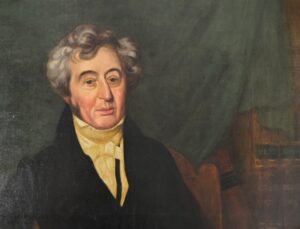
Thomas Charles of Chillington House, Maidstone by Edward Pretty (detail)
The industrialisation of the 19th century meant poor living conditions and nutrition for sections of the population. The skeletal disorder, rickets, became more widespread and pelvis deformations led to more difficult deliveries, but also to advances in obstetrics.
As hygiene and handwashing improved and rubber gloves were invented, so incidents of childbed fever declined, but it was not until the 1940s when antibiotics became available that maternal deaths from infection all but ceased.
In Britain, Government legislation relating to midwifery started with the Midwives Act of 1902. The aim being to ensure women were attended by trained and regulated professionals. It was part of a move towards state involvement in improvement to the health of the population. A raft of National Reports and legislation initiatives followed which gradually improved public health in general and maternal and child welfare in particular. From 1936 onwards women no longer paid midwives directly for their care but paid the local authority who provided a midwifery service to the local area.
During the Second World War the majority of women still gave birth at home, but there was a move towards Maternity Homes, where women could get away from disrupted living quarters and give birth in safe surroundings. Locally the Elizabethan Manor of Rumwood Court was used as a maternity hospital for army wives during the war. The image here is taken around 1920.
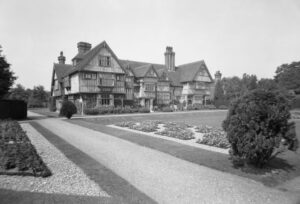
Maternity home for army wives, Rumwood Court, Sutton Road, Langley, near Maidstone, c.1920’s, from the Marley Collection
There was also a Maternity Home at West Kent General Hospital. In 1941 Maidstone resident, Mrs W Johns was admitted. We have her admission card in the collection. It is number 1272 and reads ” From the Maidstone Infant Welfare and Maternity Centre. To the Matron, West Kent General Hospital. Please admit Mrs W. Johns [ ] to the Maternity Home.”
The establishment of the NHS after the war meant that maternity care now became free and the system of antenatal and post-natal care was expanded, the trend towards hospital delivery was gathering pace, but many women still delivered at home. Miss Elizabeth Austen was a midwife in Maidstone who retired in 1974, her career covers many of the post war developments and her kit entered the Museum in 2008. Through this material we can see some of the administrative changes taking place and for the first time we have objects directly related to the process of giving birth. Among the printed ephemera is her motor car allowance form, which shows how she travelled to her cases. Labour summary sheets show her keeping track of the progress of labour and her reference books, such as Principal Drugs by A L Morton from 1945, shows what she referred to as a professional.
Drugs for pain relief have not been discussed so far in relation to birth. Nothing relating to this is present in the collection. In the Western European Christian tradition labour pains were viewed as a consequence of the Fall and something women, as the heirs of Eve, had to endure. Although various remedies were of course employed. Nicholas Culpeper writes:
“...Take Piony-Seeds, and beat them to Powder, and mix the Powder with Oyl; with which Oyl anoint the Loyns and Privities of a Woman being with Child, it giveth her Deliverance very speedily, and with less Pain than can be imagined. “
During the Victorian era chloroform was introduced for those who could afford it and pain relief was made respectable by Queen Victoria opting to use it during her confinements. More drugs became available over time, and one of the first types of pain relief midwives could administer on their own was ‘gas and air’. Early kits were cumbersome, so this was not always readily available for home confinements.
Miss Austen carried what she needed for a delivery, including syringes, pre-injection swaps, a kit for suturing and sterile umbilical tape.
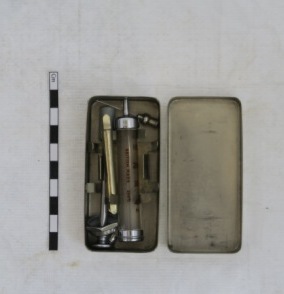
A metal box containing a 40ml hypodermic syringe stored with the plunger separated from the barrel and a needle
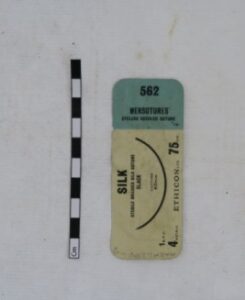
A foil packet containing a sterile single silk suture attached to a curved needle, disposable. Length (75 cm). Late 20th Century. Made by Ethicon Ltd
Finally, we will look at this image from the Billings Collection of photographic negatives. It is simply entitled, ‘Female Triplets’ and this successful multiple birth was obviously celebrated, but sadly we now have no information on who they or their proud parents were.
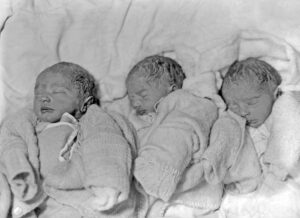
Baby Female Triplets. Photographic Negatives. UK. Billings Collection.
Care of infants
Feeding a baby is one of challenges of early motherhood. The collection has stylised and romantic depictions of Mary feeding the Christ Child. One is an icon from the Elgood bequest depicting the Madonna and Child with St. Joseph and a circa 1847 depiction of the Virgin with the Christ child by Ferdinando Paccini after Andrea del Santo.
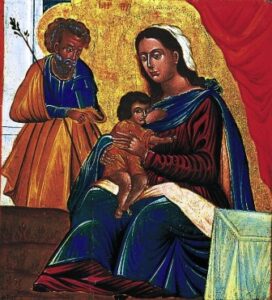
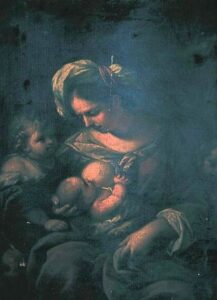
(Left image) – Icon, Elgood bequest, Madonna and Child with St Joseph, unknown artist and unknown date. (PCF 225)
(Right image) – The Virgin seated leaning over the Christ child or The Virgin and child with Saints by Ferdinando Paccini after Andrea del Santo, c.1847. (PCF230)
Wetnurses were often employed, this could be because of the death or illness of the mother, but many wealthier women chose to employ wetnurses for a variety of reasons. The practice was common until well into the 19th century. The choice of nurse was a subject of much deliberation and both Culpeper and Mrs Beeton,in her famous 1860s guide to household management, included advice on this topic. Wet nursing was a source of employment for poorer mothers. They could work for a wealthier family or work for the Parish taking in orphans for a fee.
Baby feeders are known from the earliest times. The earliest baby feeder in the collection dates to the 9th century BCE and is possibly Corinthian in origin. It was found on Cyprus and is made of clay. It was probably used to serve a mixture of wine and honey to infants.
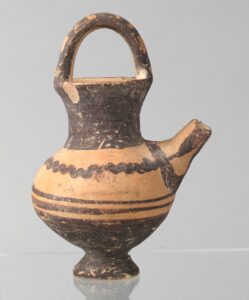
Baby feeder (800-700 BC). Photograph by Dorling Kindersley
During the 19th Century feeders would be mass produced and commercial mixtures for feeding infants started to be advertised.
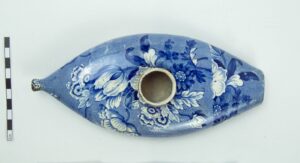
A feeding bottle. Made of earthenware with an underglaze transfer of a blue floral print. Possibly made in Staffordshire in the 19th Century.
Feeding babies using clay pots and earthenware devices could be problematic as they were difficult to clean, and infections could easily be picked up from these feeders.
The situation improved when clear glass started being used for feeding bottles. It was then possible to see if the feeder had been properly cleaned and designs improved making them easier to clean.
Models include the ‘Timothy Whites and Taylors Ideal Hygiene’ bottle, which was used at the West Kent General Hospital, and the ‘Eureka’ bottle which still has two of its original rubber teats.
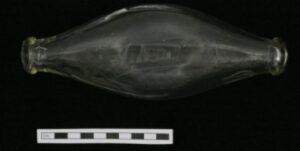
Glass baby feeding bottle embossed “Timothy Whites and Taylors ideal, hygiene”. Used at West Kent General Hospital.
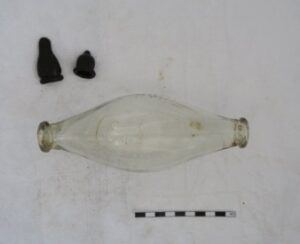
Eureka glass feeding bottle in original box, with rubber teats
The latest example in the collection was carried in the kit belonging to Maidstone Midwife, Elizabeth Austen. It is an anti-colic teat made by Cannon. Other post-natal equipment includes a cord clamp clipper, a diphtheria diagnosis kit and a booklet for screening for dislocation of the hips. These demonstrate part of the post war focus on maternity and child welfare.
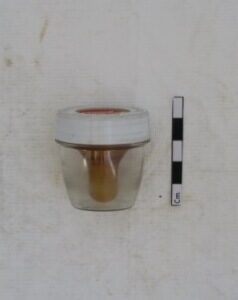
A plastic container with a large hole, anti-colic teat for feeding a baby of the make Cannon.
Representations of mothers
Depictions of Mary with the Christ Child are archetypical images of the ideal of the caring mother in the West. Other images show the mother and children as part of a fashionable and successful family. The portrait of Mawdisty Best, his wife Elizabeth and daughter Dorothy Sarah from the 17th century is a good example of this.
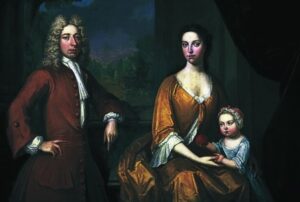
A family portrait of Mawdisty Best, his wife Elizabeth and daughter Dorothy Sarah. Attributed to Michael Dahl, 17th Century
There is a beautiful and tender portrait of Drummond’s wife and child in the collection, painted by the artist Drummond himself. It is romantic and there are echoes of traditional images of Mary and Christ in this image showing a mother in the abundant landscape cradling her child. Unfortunately, it arrived at the museum in a poor condition.
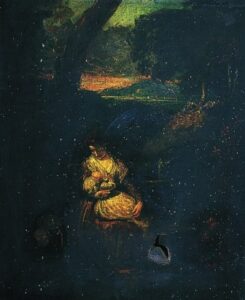
The wife and child of Drummond
Another romantic depiction of a woman and two children is by John Opie (1761-1807). It shows a lady with a young child on her lap and another child at her side. It is unclear if this is a depiction of a mother or if its meaning is intended to be more allegorical. It does however capture the romantic ideals of care and instruction given by mothers. John Opie lived at a time when new ideas on social justice were explored and, as a friend of Mary Wollstonecraft, he moved in the circles of the first feminists.
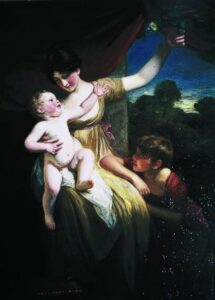
Lady with two children and a parrot by John Opie.
A lot of depictions of motherhood were romanticised and often included notions of noble sacrifice.
The watercolour by John Whitcombe called ‘Maternity’ from circa 1915 has a more wistful air. There is tenderness in the image, but there is also a sense of loneliness, which is often felt by new mothers, but rarely depicted.
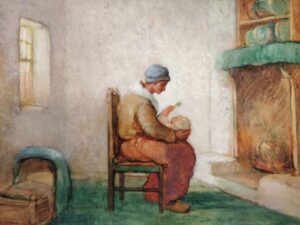
Maternity c 1915 by John Whitcombe. The artist was born in Maidstone, attended Maidstone School of Art. (Solander box red Bentlif 2 US Rack 9 C/3)
The representations of mothers have changed over time, but many of the themes of care and love run through them all.
As the final depiction of mothers in this blog we will meet the less romantic, but formidably capable looking mothers from the Mother’s Union of St Peter’s Church, Maidstone. The photo is undated but is from the middle of the last century.
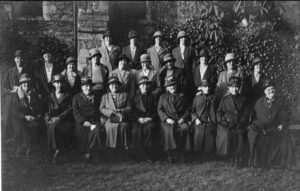
A black and white photograph postcard of the Mother’s Union of St Peter’s Church, Maidstone.
Are you curious to learn more about the history of motherhood?
Below are some of the works consulted in writing the blog. They make excellent further reading:
Thank you to Roy Moore from the Kent Photo Archive, http://kentphotoarchive.org.uk/ or help with the Billings collection images.
Beeton, Isabella, Mrs Beeton’s Household Management, Wordsworth reference 2006, first bound edition, 1861, installments 1859 to 1861.
Cassidy, Tina, Birth, A History, Chatto & Windus, London, 2007
Fraser, Antonia, The Weaker Vessel, Woman’s Lot in Seventeenth-Century England, Phoenix Press, 2002, first Published, 1984
Knott, Mother, An Unconventional History, Viking (Penguin Group), 2019
McIntosh, Tania, A Social History of Maternity and Childbirth, Key Themes in Maternity Care, Routledge, 2012
Peel, John, Croft, Sir Richard, sixth baronet (1762-1818), Oxford Dictionary of National Biography, https://doi.org/10.1093/ref:odnb/6722
Schneid Lewis, Judith, Charlotte Augusta, Princess [Princess Charlotte Augusta of Wales] (1796-1817), Oxford Dictionary of National Biography https://doi.org.10.1093/ref:odnb/5160 Accessed 20/01/2020.
Steinbach, Susie, Women in England 1760-1914, A Social History, Phoenix, 2004
Ward, Margaret, Female Occupations, Women’s Employment 1850 -1950, Countryside Books, 2008
National Trust https://www.nationaltrust.org.uk/claremont-landscape-garden/features/the-death-of-princess-charlotte
Raising Children in the Early 17th Century: Demographics, Plymouth Ancestors, https://www.plimoth.org/sites/default/files/media/pdf/edmaterials_demographics.pdf
